 |
Feast Days of Our Lady
Our Lady Aparecida – October 12
Prof. Plinio Corrêa de Oliveira
On October 12, 1717, when Brazil was still a colony of Portugal, three fishermen were out on the Paraíba River, between Rio de Janeiro and São Paulo. They were fishing with no success. Finally, one of them, João Alves, threw out his net and drew in the body of a small clay statue of Our Lady, with its head missing. Later that day, in a different place on the river, he dropped his net and pulled in the head of that same statue. After that, the fish filled the nets of the three fishermen.
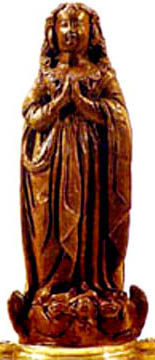
The clay statue found in the waters of Paraiba River |
Since the statue is small – only around 15” tall – João Alves and his companions considered that this incident was much more than a coincidence. Indeed, it was the beginning of a river of graces for the colony and the future independent country – Brazil. As soon as the two parts of the statue were joined together again, the statue began to be venerated by the families and neighbors of the fishermen.
It was a statue of Our Lady of the Immaculate Conception that had appeared from the river waters. Therefore, it soon became known as Our Lady of the Conception Who Appeared from the Waters, which in shortened form became Our Lady Aparecida [who appeared].
A small prayer chapel was built for the statue, and then a larger one was constructed near the site where it had appeared in the waters. From the beginning, there were many miracles. At times when the candles in the chapel would go out, they would be re-lighted of themselves. A slave in chains running from a cruel supervisor knelt at the feet of the statue, prayed to the Virgin Aparecida, and his chains loosened and came off. A blind girl was miraculously cured. A man who hated Catholicism tried to enter the chapel to break the statue, but the feet of his horse locked fast to the ground at the entrance of the building.
Miracles of all kinds took place there and the fame of Our Lady Aparecida grew and spread among the simple people. Pilgrimages from the neighboring towns became common and soon people from throughout the States of Rio, São Paulo and Minas Gerais were coming to visit the statue and ask for graces.
In 1888, a large colonial Basilica replaced the smaller chapel to host those pilgrims – whose number had already reached 150,000 a year.
Fifty years after the proclamation of the dogma of the Immaculate Conception, on December 8, 1904, St. Pius X declared Our Lady Aparecida as Queen of Brazil, and an effective coronation was made by the Cardinal of Rio. In 1931, the country was officially consecrated to Our Lady Aparecida.
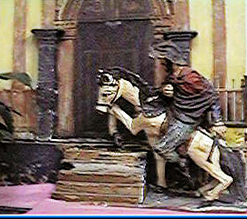
The horse of a man who wanted to destroy the statue is stopped from entering the chapel |
In 1955, construction began on a modern style new Basilica of monumental proportions that was completed in 1980. From 1959 on, however, the clergy moved the Masses to the new Basilica that was still under construction. It was a common knowledge that the Statue that was now housed in the new Basilica would appear miraculously every morning back in the colonial old Basilica. It was as if she were saying that she did not like the modern style of the new building. After many years passed with this miracle occurring daily, it stopped, perhaps because no one responded to her obvious desire to remain in the old Basilica.
After the Council, many reforms of a Protestant bent were introduced into the liturgy and the progressivist doctrine conquered in the Church. With this came a general coldness regarding veneration of Our Lady. These reforms were accepted in Brazil with indolence and indifference, without any special reaction against them. Further, immorality in the customs was rapidly growing, and divorce was approved by the Congress. This ensemble of anti-Catholic attitudes were the causes, in my opinion, of the desecration of the Holy Statue of Our Lady Aparecida that took place there in 1978.
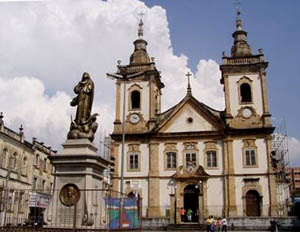
Above, the old Basilica, preferred by Our Lady Aparecida. Below, the modern, massive new Basilica
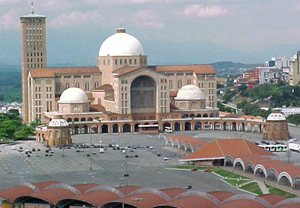
|
Indeed, on May 16, 1978, a member of a Protestant sect took the statue from her niche after the last Mass of the day. He was chased by guards and some of the faithful. As he was caught, the statue fell to the ground breaking to pieces. Her face in particular was damaged. Because the statue was made of clay that had been submersed in water for a long time, it was difficult to put the pieces back together. It was done, however, and the original expression was recaptured as much as possible. The symbolism of the incident is very eloquent.
These are the main facts that characterize the history of Our Lady Aparecida. The miracles and graces have never stopped, especially for the simple people who are the ones who more often have recourse to Our Lady Aparecida. At some special festivities, more than one million pilgrims visit the statue in a single day, making Nossa Senhora Aparecida one of the most popular Marian sanctuaries in the Catholic world.
What do these facts suggest to us?
First, there is something very beautiful regarding the devotion to Our Lady, which in certain ways is similar to feudalism. There are some great devotions of Our Lady that are universal, like the devotion of Fatima, Lourdes, Our Lady Help of Christians, among many others. Then we have the devotions of whole continents, like Our Lady of Guadalupe, the Patroness of the Three Americas. There are national devotions, like the one we are celebrating today, Our Lady Aparecida, who is the Patroness of Brazil.
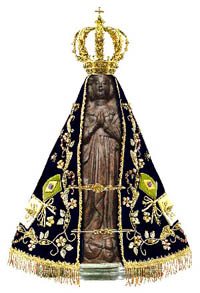
Queen and Patroness of Brazil |
But there are also devotions of Our Lady that are specific to certain regions, like the devotions of Our Lady of the Pleasures in the State of Pernambuco and Our Lady of the Dew in the State of Paraná. There are also devotions that are characteristics of cities, like Our Lady of Penha [cliff] in São Paulo. There are some devotions that are adopted by a parish, like Our Lady of the O, which gave her name to one of the neighborhoods of our city. And finally some families have a special devotion to a particular invocation, like my family’s devotion to Our Lady of Piety.
We see that Our Lady with her maternal spirit shows herself both as great and small, to appeal to all persons of every level. She becomes universal for the large communities, but she also chooses to be regional, proportional to each human group.
This way we can admire her different dimensions: a Queen in large communities and a Mother in the smaller ones. It is very salutary to admire her and be united to her in every dimension, every place, every meaning. In this way we can always consider her from new aspects and points of view.
Second, in this light, how should we consider the graces of Our Lady Aparecida?
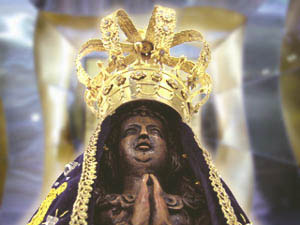
Our Lady responds to the requests of the little people |
This devotion is popular among all classes, but most particularly the lower classes. The poor and suffering people from neighboring States go to Aparecida to ask Our Lady for help and relief in their material difficulties. This devotion spread primarily among the simple people, who continue to be its main support. It is a devotion with a humble birth to bring Our Lady close to the humble people. Our Lady assists the pilgrims, curing them of this or that illness, resolving some difficult family situations, or securing a job for a son or daughter.
Our Lady gives the people these graces because she loves them and she is the Mother of Mercy, but also to persuade them to come to her in all their needs, which is per se a stimulus to the grace of prayer. It also encourages them to ask not only for material things but for greater things - progress in their spiritual lives and the salvation of their souls. It is a way to invite them to think more often about God and His glory.
Even for persons advanced in the spiritual life, there is an advantage in receiving graces to resolve small material problems. This allows them to experience the goodness of God and to love Him more.
Third, the fact that Our Lady of the Immaculate Conception appeared in the waters of the Paraiba River in 1717, more than a century before this dogma was proclaimed by Pope Pius IX, was a strong stimulus for Brazilian Catholics to believe in and be prepared for that dogma.
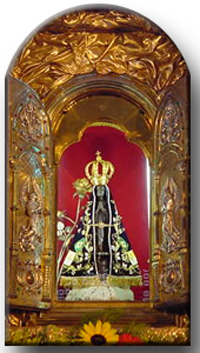
Millions of pilgrims visit the niche of Our Lady Aparecida annually |
We know that since the beginning of the Church the Immaculate Conception of Our Lady was believed by many and was contested by many. Countless polemics over this topic took place through the centuries, with Doctors and Saints on both sides. The great St. Thomas Aquinas, for example, did not think it was possible for anyone to be conceived without original sin. He was mistaken, as were many others. Pope Pius IX closed the question with his famous argument: God could have created a person without original sin; He desired to do so; therefore, He created such a person. In Latin this has a lapidary formulation: Potui, volui, ergo fecit [He could do it, he wanted to do it, and therefore, He did it].
Our Lady chose Brazil to appear under the invocation of the Immaculate Conception to give us a concrete confirmation that she was born without original sin and affirm that this truth should be believed. The treasure chest of graces and miracles she opened after her apparition provides us evidence of this truth.
On this feast day of Our Lady Aparecida, Queen of Brazil, we should ask that she establish in this country and the rest of the world the Reign of Mary that she promised. We should also ask to be worthy of being the apostles and builders of this Reign. And we should ask her for the needed generosity to carry out whatever she thinks necessary – crusades, polemics, sacrifices and sufferings – so that this triumph might be achieved.


  | | Prof. Plinio Corrêa de Oliveira | |
The Saint of the Day features highlights from the lives of saints based on comments made by the late Prof. Plinio Corrêa de Oliveira. Following the example of St. John Bosco who used to make similar talks for the boys of his College, each evening it was Prof. Plinio’s custom to make a short commentary on the lives of the next day’s saint in a meeting for youth in order to encourage them in the practice of virtue and love for the Catholic Church. TIA thought that its readers could profit from these valuable commentaries.
The texts of both the biographical data and the comments come from personal notes taken by Atila S. Guimarães from 1964 to 1995. Given the fact that the source is a personal notebook, it is possible that at times the biographic notes transcribed here will not rigorously follow the original text read by Prof. Plinio. The commentaries have also been adapted and translated for TIA’s site.
|
Saint of the Day | Home | Books | CDs | Search | Contact Us | Donate

© 2002- Tradition in Action, Inc. All Rights Reserved
|
 |

|